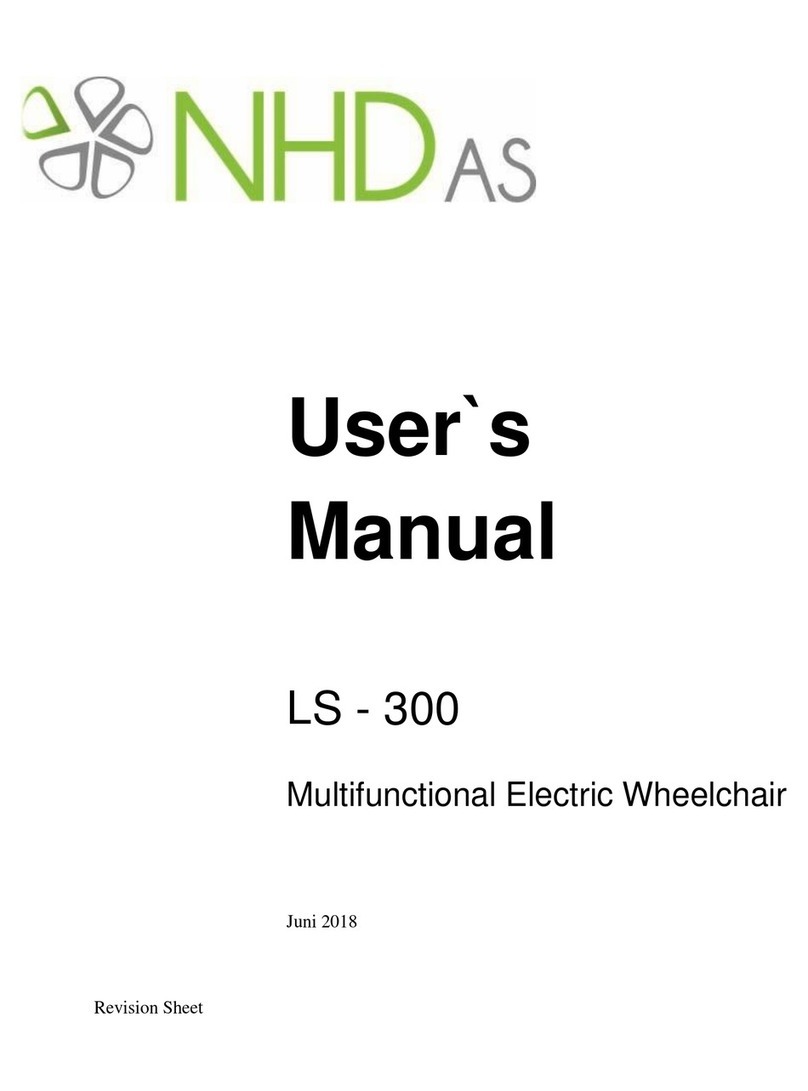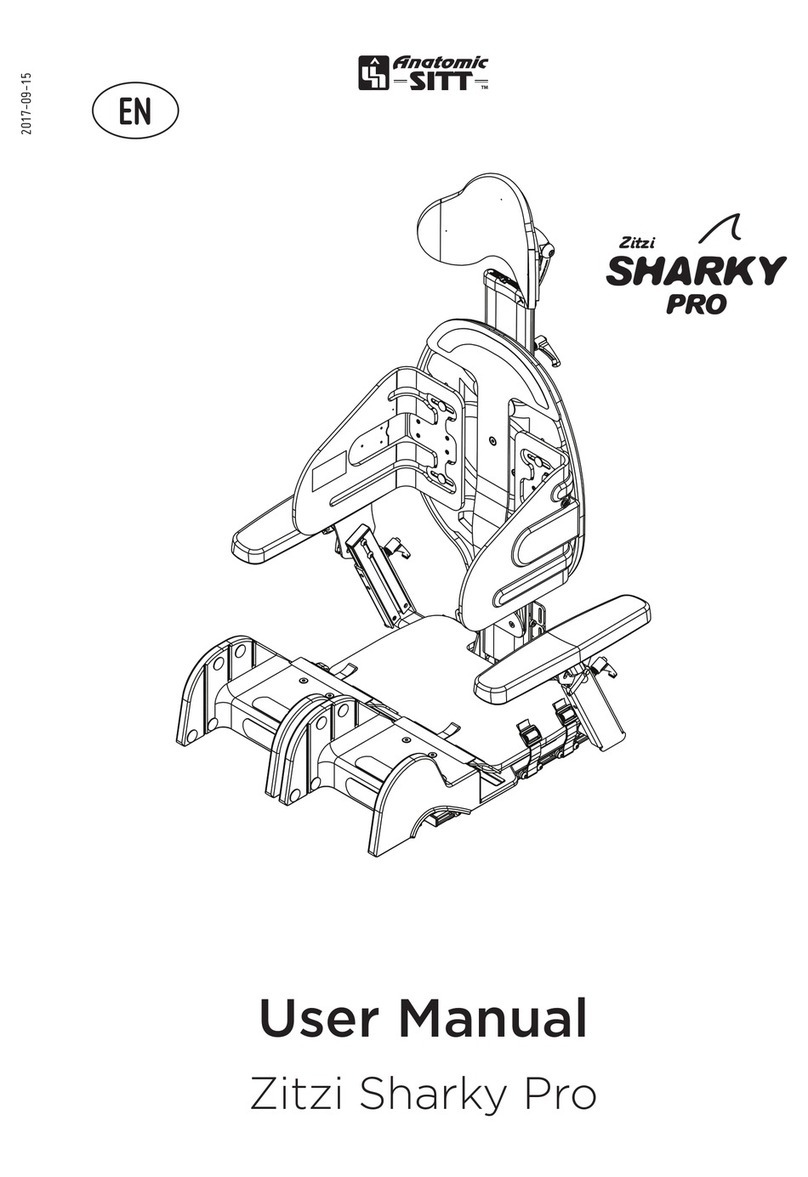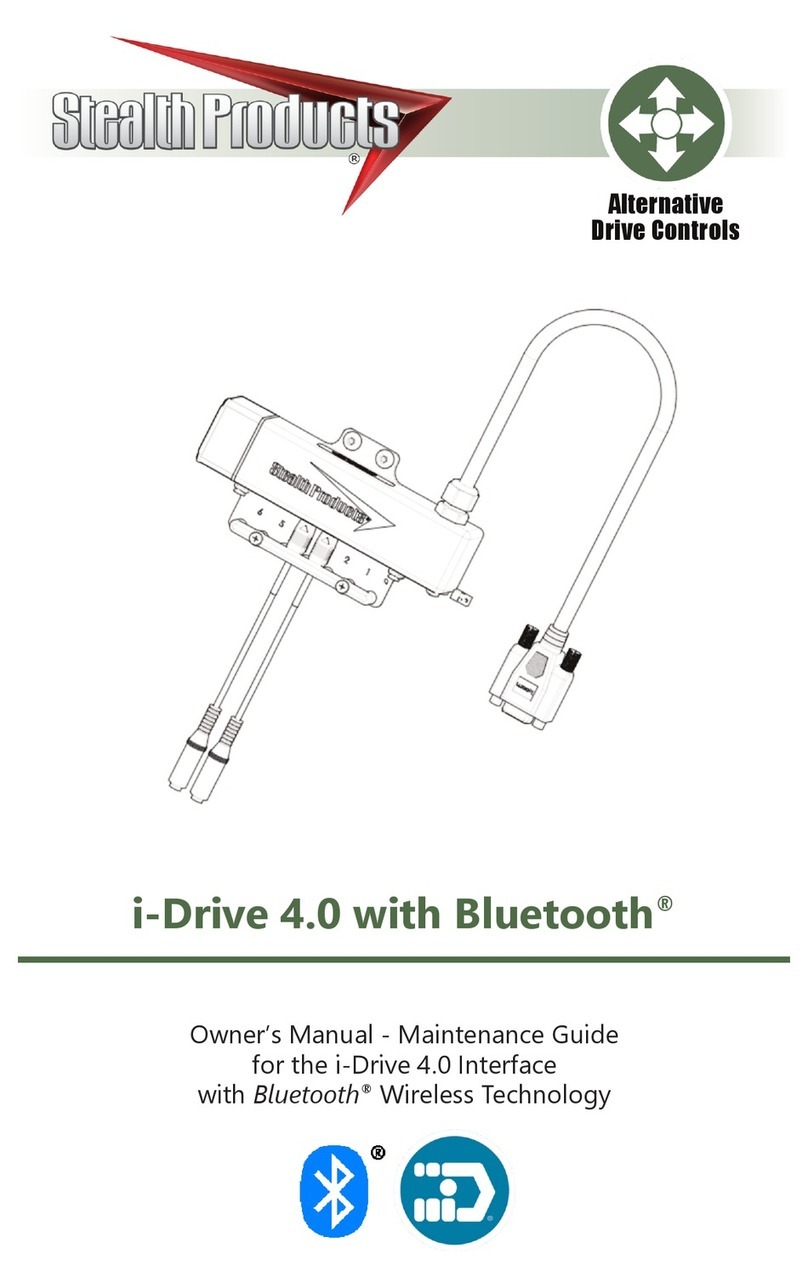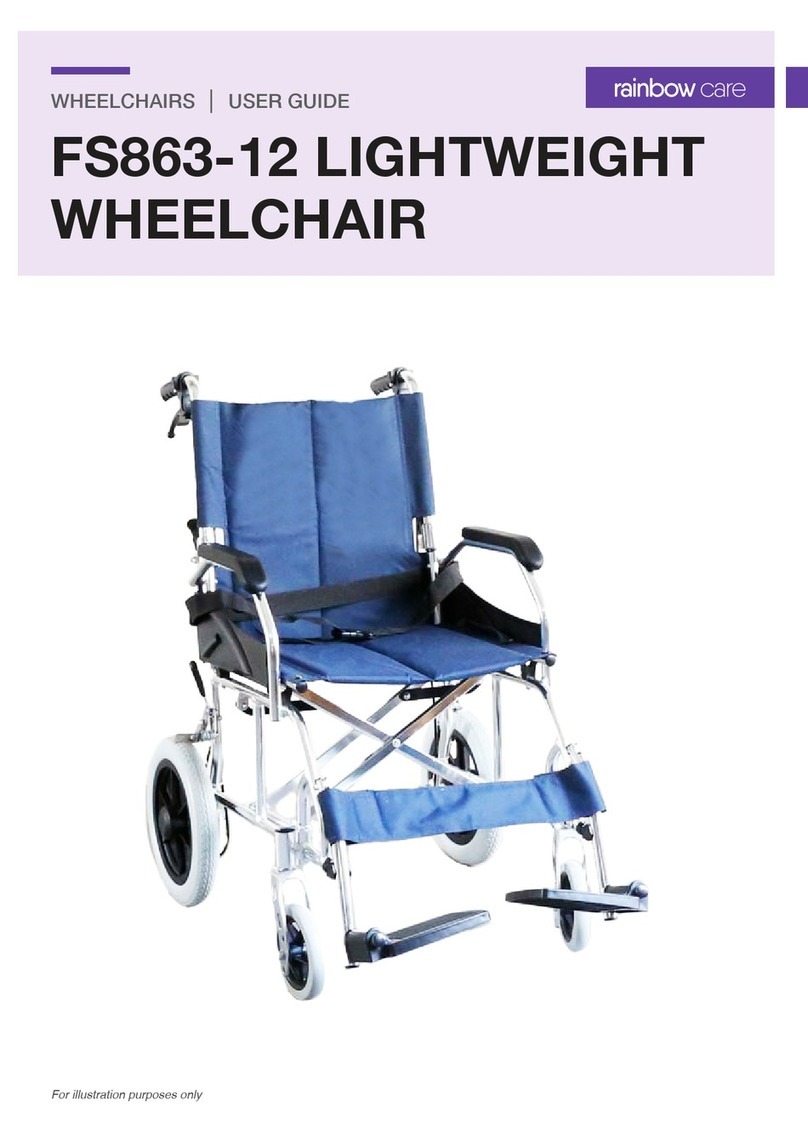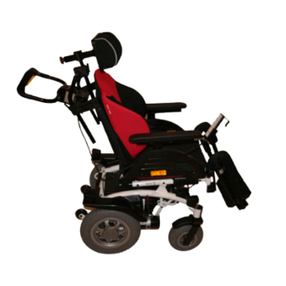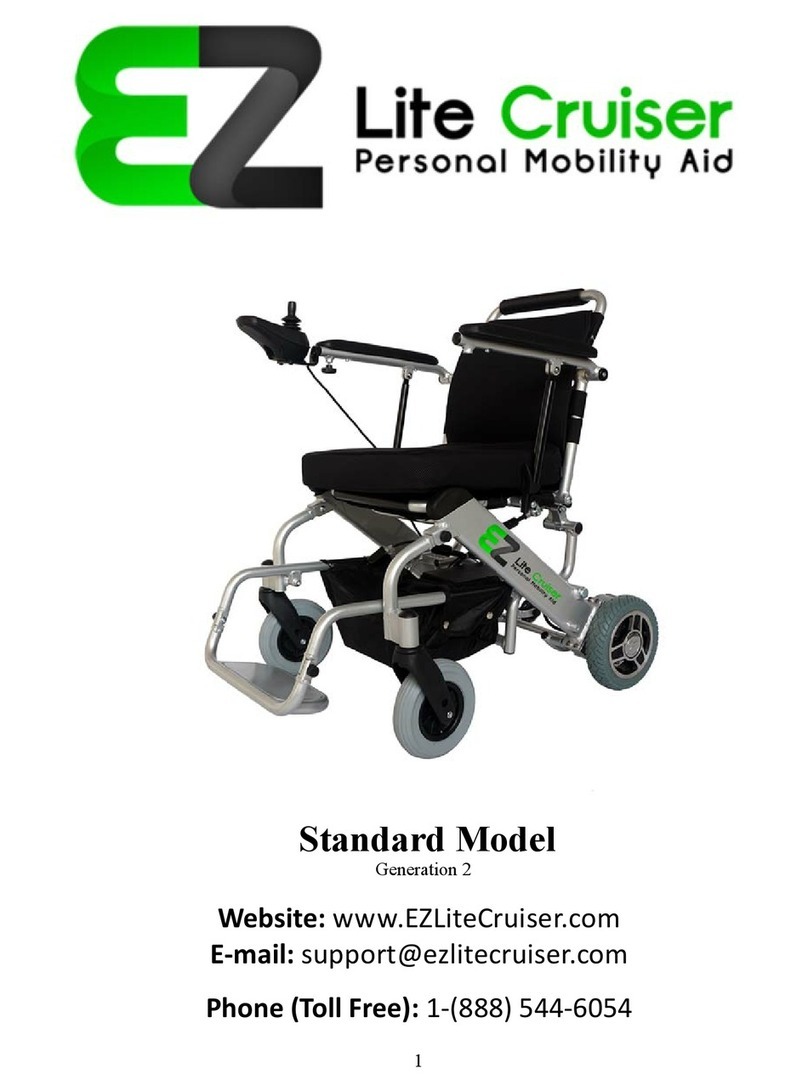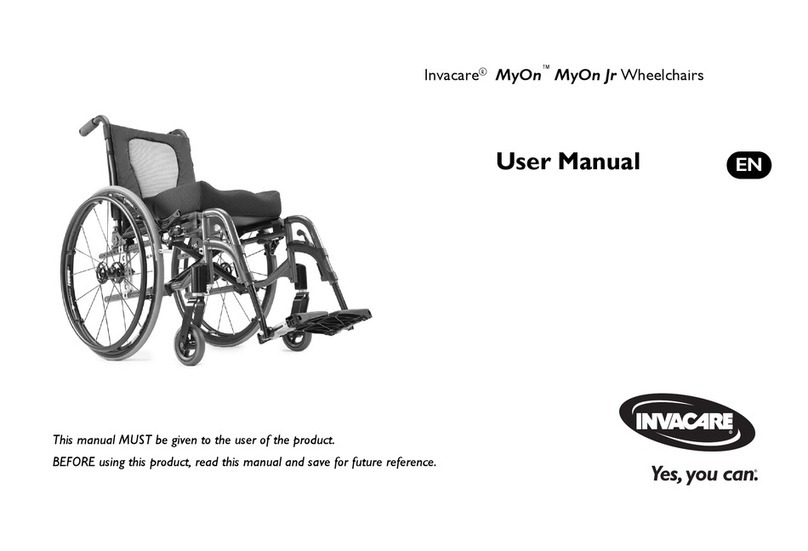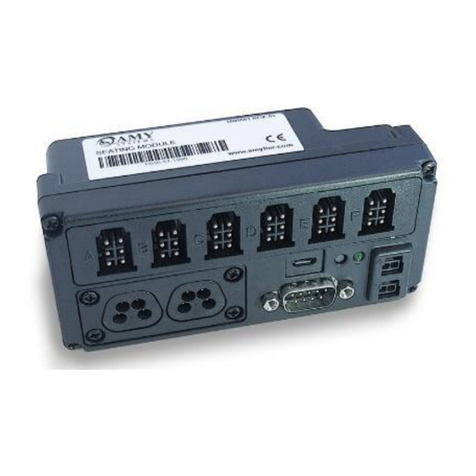NHD AS LS-300 User manual

User`s
Manual
LS - 300
Multifunctional Electric Wheelchair
December 2020

User`s Manual LS-300 Page ii
Revision Sheet
Release No. Date Revision Description
Release 5.0 11.08.2020 Modification of the chapter 4.
Release 5.0 02.12.2020 Addition to chapter 4 - Adjustment armrests.
Serial number label for this LS-300

User`s Manual LS-300 Page iii
1. Preliminery note ...........................................................................................................................................2
2. Important safety instructions.......................................................................................................................3
General safety instructions ................................................................................................................................................ 3
Notes on EMC interference................................................................................................................................................ 4
Brakes................................................................................................................................................................................. 4
Intended Use ...................................................................................................................................................................... 4
Indications.......................................................................................................................................................................... 4
Contraindications ............................................................................................................................................................... 4
Declaration of conformity .................................................................................................................................................. 4
3. Product Overview .........................................................................................................................................5
Delivery .............................................................................................................................................................................. 5
Check the delivery.............................................................................................................................................................. 5
Identification label ............................................................................................................................................................. 5
Overview ............................................................................................................................................................................ 6
4. Use of the wheelchair...................................................................................................................................7
Basic settings...................................................................................................................................................................... 7
Control................................................................................................................................................................................ 7
Adjustments and equipment..…………………………………………………………………………………………………………………………………….12
Getting in and out……………………………………………………………………………………………………………………………………………………….15
5. Technical specifications..............................................................................................................................16
Charging ........................................................................................................................................................................... 19
Service information .......................................................................................................................................................... 20
6. Examination of the wheelchair...................................................................................................................21
Checking the brakes ......................................................................................................................................................... 21
Checking the tires............................................................................................................................................................. 21
7. Cleaning and disinfecting ...........................................................................................................................22
Cleaning............................................................................................................................................................................ 22
Disinfection ...................................................................................................................................................................... 22
Re-use of the wheelchair.................................................................................................................................................. 22
8. Maintenance ..............................................................................................................................................23
Replacing the batteries .................................................................................................................................................... 23
The Power supply of the wheelchair…………………………………………………………………………………………………………………………..22
Repair / maintenance plan ............................................................................................................................................... 24
9. Transport....................................................................................................................................................25
Guideline for transportation in a vehicle…………………………………………………………………………………………………………………….25
Transportation using Dahl docking station………………………………………………………………………………………………………………….30
Device for attach the wheelchair………………………………………………………………………………………………………………………………..33
10. Storage...................................................................................................................................................34
11. Disposal.................................................................................................................................................. 34
12. Warranty................................................................................................................................................34
13. Pre-Sale Information..............................................................................................................................35
14. Manufacturer.........................................................................................................................................40

User`s Manual LS-300 Page 2
1. Preliminery note
Thank you for purchasing a LS-300 multifunction wheelchair. The LS-300 can be optimally
adapted to your physical needs. All settings can be adjusted electronically, steplessly via the
joystick. You can adjust seat height, seat angle, backrest angle, knee angle, armrest position,
footplate position and leg length. Its size combined with its high functionality makes it ideal for
indoor and outdoor use.
Please charge the battery completely before first use, see Chapter 4 „Charging“.
To get the most out of all the benefits of this wheelchair, read the instructions carefully, do not
throw it away, but keep it handy.
Maintenance work or technical repairs may only be carried out by authorized specialist dealers.
LS-300 is a Class B electric wheelchair designed for use in- and outdoors.
LS-300

User`s Manual LS-300 Page 3
2. Important safety instructions
General safety instructions
•To avoid falls and accidents, it is important to familiarize yourself with your new wheelchair
in a safe environment, on a level surface. We recommend to bring in a companion at the
beginning.
•When adjusting and the wheelchair there is a risk of entrapment for the user as well as for
third persons who are in the immediate vicinity of the wheelchair.
•Avoid driving against steps or curbs.
•When transporting the wheelchair, it must be secured against rolling away. Use the fastening
devices.
•In the event of prolonged exposure to the sun, parts of the wheelchair may heat up, there is a
risk of burns.
•Weight transfer due to body movement or load may increase the risk of tipping.
•Please do not hang objects such as carrying bags, backpacks etc. on the wheelchair, this is not
intended. Attached loads, change the statics and can lead to falls and modified braking
behavior.
•When driving on uphill or downhill gradients, make sure that the seat surface is not raised as
this will limit the stability and can cause the wheelchair to fall over.
•Note that the braking distance is longer on inclines than on level ground.
•When overcoming slight obstacles or height differences, you should raise the seat slightly, if
at all, and leave the backrest as steep as possible to prevent the wheelchair from tipping over.
•Do not bring damaged batteries into contact with skin, as the contents of the battery are
harmful to health and can be corrosive.
•Only charge the battery in ventilated areas.
Be sure to keep your arms
and hands on the armrest
during electrical adjustment
of the wheelchair. Third
parties should not touch the
marked areas with their
hands or fingers.
Entrapment!

User`s Manual LS-300 Page 4
Notes on EMC interference
•While all EMC directives have been met, the electric wheelchair may be affected by other
electrical systems or interfere with these, such as electric motors, electric doors, alarm
systems, mobile phones, and other electrical systems that emit EMC noise. It may also be so
that the wheelchair can disturbe other electrical systems
Brakes
The wheelchair brakes to a halt when the joystick is released. The functionality should be
checked before each use.
Attention: On gradients, the braking distance is extended.
Intended Use
The wheelchair is exclusively for the transport of disabled persons.
Indications
Inability to walk or severe disability caused by
• paralysis
• Joint contractures, joint damage - not on both arms
• loss of limbs
• Limb injury
The use of an electric wheelchair is intended for persons who, due to the disability, are unable to
carry hand-driven wheelchairs, but have the ability to properly operate the electric wheelchairs.
Contraindications
Electric wheelchairs are unsuitable for people
• with reduced eyesight
• with severe balance disorders
• with severe limitations of cognitive abilities
• with inability to sit
Declaration of conformity
NHD, as the manufacturer, declares on its sole responsibility that the LS-300 electric wheelchair
complies with the requirements of EU MDR Regulation 2017/745.

User`s Manual LS-300 Page 5
3. Product Overview
Delivery
After receiving your goods, please check the contents for completeness
Packing
Electric wheelchair
Control device
Charger
Check the delivery
Your LS-300 wheelchair is delivered ready for use, no further assembly is necessary.
Please check if all listed elements are present.
Identification label
The identification label is located behind the right drive wheel.
•Manufacturer
•model
•Item number
•Max. user weigth
•Max. safe gradient
•CE mark
•Production date

User`s Manual LS-300 Page 6
Overview
A Headrest
B Backrest
C Armrest
D Electrical control with connection for the charging unit
E Seat cussion
F Footrest
G Rear Wheel
H Front Wheel
I Footrest plate
J Battey unit
K Identification label
Upon request, your wheelchair will be delivered with a lap belt, which is attached to the side of
the seat plate. This belt does not serve as a safety belt during car rides. To close, push the two belt
parts into each other until they click into place. Open the clasp by pressing on "Press". “For
optional parts contact our authorized dealers”.

User`s Manual LS-300 Page 7
4. Use of the wheelchair
Basic settings
The individual mechanical adjustments before the first use of your electric wheelchair, must be
made by the authorized dealer. Such settings may effect the stability of the chair.
The LS-300 has as a standard control systems / joystick module CJSM-L-SW.
Control
With the control you control the settings of your wheelchair, as well as the driving characteristics.
The control offers the possibility to electronically adjust the seat adjustment, it is located on the
right armrest and can be operated with little force.
Please read carefully the safety instructions before first use.
Press the upper button to turn on the controller.
The "Mode" button takes you to the two main menus, setting mode or driving mode.
II
III

User`s Manual LS-300 Page 8
Attention: LS-300 has an alternative control systems / joystick modules.
The LS-300 can be supplied with the Joystick Modules CJSM2
Setting
Attention: Please note that major changes, such as extreme positioning of the backrest or leg rest
and / or high height adjustment, can negatively affect the stability. Also, the braking distances can
be extended. If you have any questions, please consult your dealer.
If one or more areas of the wheelchair light in the display next to the Mode button lights up, you
are in setting mode. With a right or left movement of the joystick you can switch between the
areas to be set. If you move the joystick forwards or backwards in this mode, you change the
position of the illuminated areas.
The following ranges can be infinitely adjusted via the control:
- Backrest at an angle
- seat angle
- Length of legrests
- Angle of legrests
- Seat height

User`s Manual LS-300 Page 9

User`s Manual LS-300 Page 10
Driving mode
If you press the on-off switch, if no areas in the display next to the mode button light up, you are
in driving mode.
When you move the joystick forward, the wheelchair moves forward.
Brake by releasing the joystick. By releasing the joystick the wheelchair comes to a standstill.
To change from the setting to the driving mode, proceed as follows:
Press the Mode button, move the joystick to the right (or left) until no areas in the display next to
the Mode button light up.
Speed
The speed is controlled while driving with the joystick, if you move the joystick only slightly, the
ride is slower. Push the joystick to the stop to drive maximum speed. The maximum speed can be
set in advance in five different driving profiles. (see section driving profiles)
Set driving profiles
You can define five different driving profiles with the controller. This allows the maximum speed
to be programmed differently. Especially indoors it is recommended to set the maximum speed
lower. Press the "Mode" button and move the joystick up or down to access the corresponding
menu. With the help of the selector keys you can now preset the maximum speed and specify it in
one of the five possible profiles.
Change of direction
If you move the joystick to a side position while driving, the wheelchair follows and moves in
that direction.
Attention: The wheelchair has a low turning radius, make sure that no people or objects are too
tight and you or others injured.
For reversing, move the joystick towards you.
Attention: Please make sure that there are no persons or obstacles behind you.
Overcoming obstacles
To climb up kerbs, steps or other use ramps or lowered areas. If not possiböe, drive slowly and
head-on towards the obstacle to be overcome, staying about 50 cm in front of it. Make sure the
wheels are perpendicular to the obstacle. Now drive at a steady, sufficient speed over it.
Attention: Do not try to drive over obstacles higher than 50 mm.
Do not drive over the obstacle at an oblique angle, there is a risk of tipping.
Steep terrain
Note that the maximum slope you can drive it 6°. If you drive forward be sure that your lean
backwards as far as possible. Select an Mode with reduced speed and brake softly.
Attention: Do not drive over an oblique angle higher than 6°, there is a risk of tipping.

User`s Manual LS-300 Page 11
Freewheel function
The power wheelchair can be set in a manual sliding mode. This function may only be set by a
companion. The following step is necessary for this:
Loosen the center handles on the brake release handles. ("Unlock" and "lock")
Attention: The wheelchair has no braking function in sliding modeThe controller is
automatically switched off in this mode.
After the shift, switch the system back to normal operation. If the controller is not yet active,
switch it off and on again, now your electric wheelchair is again driveable.
Lock with the help of the controller
To secure the control, please proceed as follows:
Press the ON button until a beep sounds. Release the button and slide the joystick forwards until
you hear another beep. Release the joystick. Then move the joystick backwards until you hear
another beep, release the joystick and a long beep sounds. The electric wheelchair is now locked
against driving away. They realize. To unlock the wheelchair, follow the same procedure.
Armrests
The armrests can be folded up completely to make getting in easier.
Foot plate folded up
Freewheel function

User`s Manual LS-300 Page 12
Adjustments and equipment
Upholstered lateral support (optional)
The optional upholstered lateral support offer support on the upper body. The supports are
adjustable in height, width, depth and angle. The supports can also be flipped sideways for
transferring in or out of the wheelchair. During this sideways flipping the adjustments stay intact.
The soft rounded pads ensure optimal support and great comfort.
Upholstered lateral supports
Height adjustment armrests
Height adjustment is made by shortening the Adjustment Sleeve (A) (raising the armrest) or extending
(lowering the armrest) using the inner threaded rods in it. Unscrew the lower attachment (B) and
loosen the lock nut (C). Then rotate the adjusting sleeve and the inner threaded rods to such a length
that the desired height of the armrests is achieved. Mount in reverse order.
Adjust the angle of the armrest cushion
To adjust the angle of the armrest cushion, loosen the screw (A), then loosen the screw (B) and the
angle can be adjusted. Tighten screw (B) and then screw (A) again.
Always perform a load test to check that the armrest is properly attached.
Exterior (locknut) Inside (5mm Allen key)

User`s Manual LS-300 Page 13
Lateral support settings
The optional lateral support can be adjusted step less in height, depth, width and angle.
Set the height of the lateral support.
Step 1: loosen up the bolts (R) using a 5mm Hex key.
Step 2: move the lateral support in to the required height.
Step 3: tighten the bolts.Adjust the depth width and angle of the lateral support.
Step 1: loosen the bolts (S) of the friction joints.
Step 2: move the pad into the required angle, depth and width.
Step 3: tighten the bolts to fixate the setting.

User`s Manual LS-300 Page 14
Seat belt (optional)
For positioning, several types of belts are available.
Seat belt (installation)
The optionally positioning belt can be adjusted in lenght and anchoring point. To change the
setting simply follow the next steps :
Step 1: loosen the bolts (T) using a 4mm Hex Key.
Step 2: move the bracket in the required position.
Step 3: fasten the bolts.
Caution:
Make sure the brackets are tighten properly to avoid
sliding of the seat belt along the seat rail. A sliding seat
belt might result in poor seating position of the user.

User`s Manual LS-300 Page 15
Hooks for extra load such as backpacks and bags. (optional)
The hooks are placed on the back of backrest near the base of the headrest. See picture.
Lifting points
“The chair is 168 kg heavy. We recommend no manual handling of the chair. If the chair must be
lifted it can be lifted in the rings on the back of the chair and on the inside of the front wheel. See
pictures on Chapter 9 Transport.
Getting in and out
Bring your current seat as close as possible to the side of the LS-300. Make sure that the
controller is turned off to prevent uncontrolled rolling. Fold up the armrest and footplate. Now
slip sideways onto the seat of the LS-300, making sure that you are as far back as possible in the
seat. Now fold down the footrest and the armrest again.

User`s Manual LS-300 Page 16
5. Technical specifications
Specification according ISO 7176-15:1996
Maximum occupant mass: 136 kg
Mass of the test dummy according ISO 7176-11:2012: 136 kg
Overall length (with leg rest) 1140 mm
Overall width: 630 mm
Folded length: 970 mm
Folded width: 630 mm
Folded height: 1145 mm
Total mass: 168 kg
Mass of the heaviest part (battery) 21,5 kg
Static stability downhill: 9 °
Static stability uphill: 9 °
Static stability sideways: 9 °
Teoretical distance range*): 53 km
Dynamic stability uphill: 6 °
Obstacle climbing: 50 mm
Maximum speed forward: 9 km/h
Minimum braking distance from
maximum speed:
1448 mm
Seat plane angle: 0 - 15 °
Effective seat depth: 500 mm
Effective seat width: 420 - 520 mm
Seat surface height at front edge : 410 - 850 mm
Backrest angle: 2 - 47 °
Backrest height: 500 mm
Footrest to seat distance : 390 - 535 mm
Leg to seat surface angle: 8 - 50 °
Armrest to seat dictance: 200 mm
Front location of armrest structure : 350 mm

User`s Manual LS-300 Page 17
*) Use in steep conditions or rough ground etc. will have negativ impackt on the distance.
The wheelchair conforms to the following standards:
1. requirements and test methods for static, impact and fatigue strengths (ISO 7176-8)
2. power and control systems for electric wheelchairs requirements and test methods (ISO 7176-
14)
3. climatic test in accordance with ISO 7176-9
Further Specificatons
Headrest: 1,5 kg
Uneven ground: 30 mm
Ground clearance: 60 mm
Steering range: 1250 mm
Turning area: 1150 mm
Overall height: 1145 mm
Seat width: 460 mm
Length of the armrest: 420 mm
Sound level: 67,8 dB(A)
Operating forces
Joystick: ca. 1 N
Button ca. 1 N
Coupling and decoupling of the drives: 60 N
Tires
Tire pressure: 250 kPA
Rear tires: 205 Ø mm
Tires in front: 345 Ø mm
Horizontal location of axle: 250 mm
Minimum turning radius 770 mm

User`s Manual LS-300 Page 18
Electrical
Control: PG dt R-net
Batteries:
Valve Regulated Lead Acid, Gelled
Electrolyte Battery
12V 60Ah
Charger: Medico CCC 410S
Environmental conditions
Temperatur: Actuators: -10 °C- + 60 °C
Engine: 10 °C- + 60 °C
Humidity: 60% ± 20 %
Storage conditions
Temperature: -45°C to 70°C
Humidity: 60% ± 20 %
Materials
Frame: Steel powder-coated, corrosion-protected
Attachment parts: Steel / aluminum powder-coated anodised
Seat cushion: Flame retardant according to EN 1021-1 / 2
Back cushion: Flame retardant according to EN 1021-1 / 2
Armrest cushion: Flame retardant according to EN 1021-1 / 2
Other manuals for LS-300
2
Table of contents
Other NHD AS Wheelchair manuals
Popular Wheelchair manuals by other brands
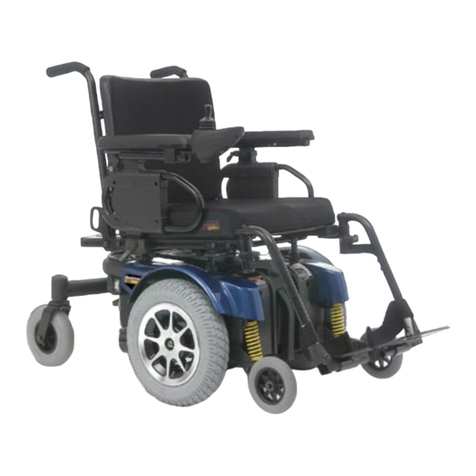
Quantum
Quantum Quantum 1121 Series Specifications

DeVilbiss Healthcare
DeVilbiss Healthcare drive AirFold Instructions for use
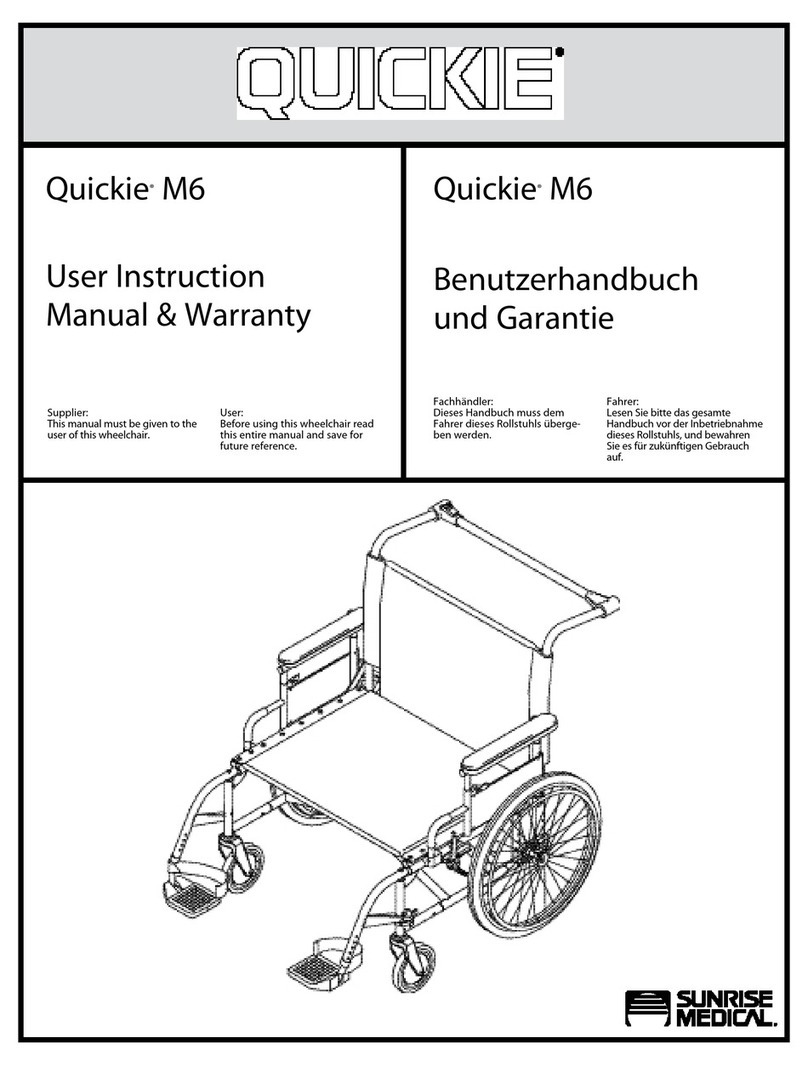
Sunrise Medical
Sunrise Medical Quickie M6 User instruction manual & warranty
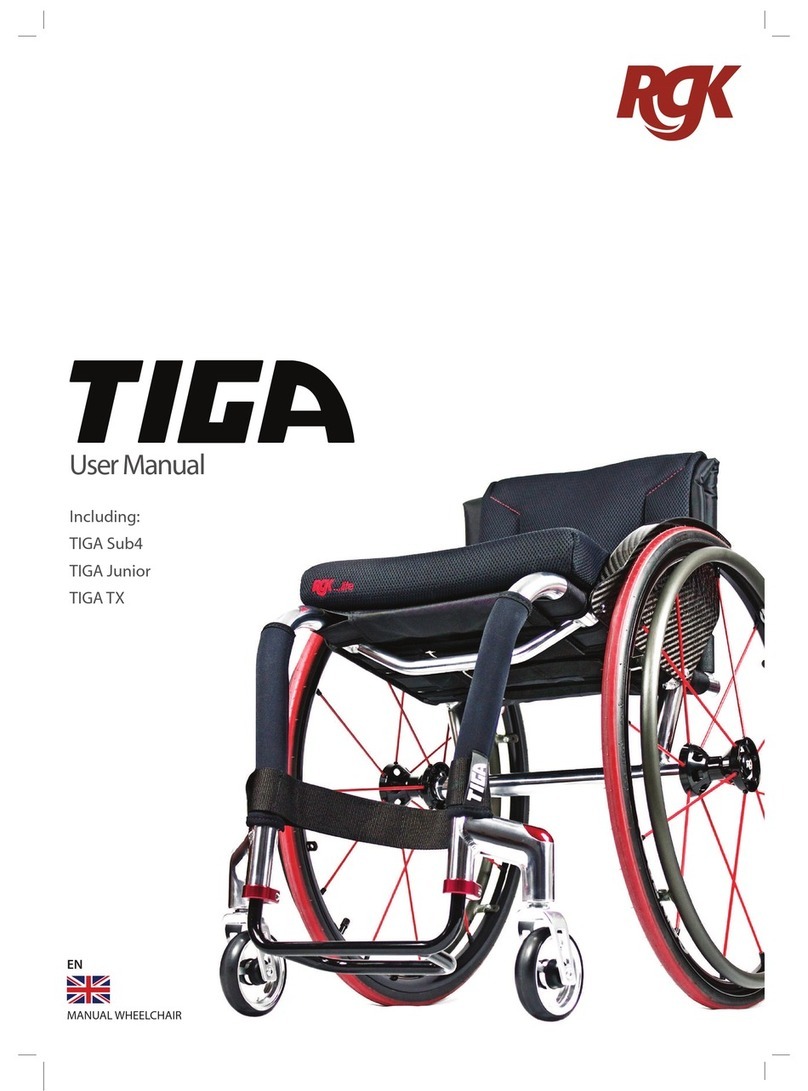
TIGA
TIGA Sub4 user manual

max mobility
max mobility SmartDrive MX1 user manual

Sunrise Medical
Sunrise Medical Quickie LXI User instruction manual
